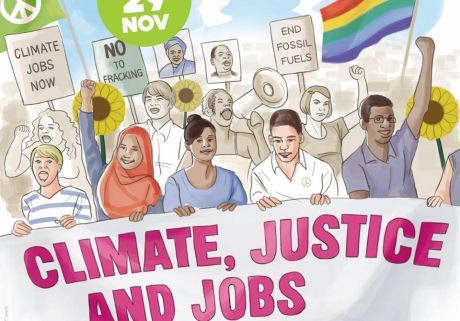Features
You are here
Push Trudeau for climate jobs now

February 24, 2016
Coming out of the COP21 negotiations in Paris, Prime Minister Trudeau has promised billions in investment and infrastructure, but will it be for greenwashing or for climate jobs?
Greenwashing
Trudeau agreed to the climate target of keeping global warming below 1.5 degrees, but how will this be achieved? BC Premier Christy Clark is trying to channel infrastructure spending into a $3 billion plan for a freeway bridge and is greenwashing it as a climate plan—claiming it would “reduce our impact on the environment because there will be less idling.”
Meanwhile Alberta Premier Rachel Notley’s so-called climate plan is centered on preserving tar sands production. Now that collapsing oil prices have sunk Alberta’s economy, the provincial and federal government are running to the rescue of the tar sands rather than using the opportunity to rapidly shift to a sustainable green economy. As Greenpeace Canada climate and energy campaigner Mike Hudema said, “We support Prime Minister Trudeau’s and Premier Notley’s pledges to act on climate and to live up to Canada’s global climate commitments but building more pipelines will make those goals impossible. We simply can’t add tens of millions of tonnes of additional greenhouse gases to the atmosphere for decades and call it climate leadership.”
At the same time, Bombardier is laying off thousands more workers and demanding a huge bailout to finish a series of aircrafts, rather than focusing on trains. Quebec Premier Phillip Couillard has promised $1 billion and asked the federal government to match these funds.
Investing in highways, pipelines and aircrafts will only worsen the climate crisis—disproportionately affecting Indigenous communities and refugees—and offer no long-term strategy for workers in high carbon industries. As tar sands worker Ken Smith said at the Paris climate talks, “We hope we’re seeing the end of fossil fuels for the good of everybody. But how are we going to provide for our families?” Smith, a heavy equipment mechanic and president of Unifor local 707A, said that if tar sands production has to wind down, workers should not be left behind in the process. He pointed to the failed jobs transition program for fisheries workers in the Maritimes as an example of how workers have been abandoned in the past.
One million climate jobs
That’s why climate job campaigns are so important, to link the fights against austerity and climate change. In Britain workers occupied a windmill factory against closure in 2009, sparking a campaign for a million climate jobs. In 2011 the million climate jobs campaign was launched in South Africa, to transition away from mining while reducing unemployment and carbon emissions. In New York the campaign to ban fracking has developed demands for alternate jobs in retrofitting buildings.
Now the campaign for a million climate jobs has come to Canada. In a release last month, the Climate Action Network—which includes the Canadian Labour Congress—stated that a key goal of Canada's Environment Ministers should be “creating at least one million jobs to deliver deep (green house gas emission) reductions from investments such as renewable energy, energy efficiency in buildings and in delivering public transit, and higher speed rail.”
The proposal for one million climate jobs gained high profile support in Paris when the Canadian Labour Congress, the Green Economy Network (GEN) and the Climate Action Network hosted a forum outlining the urgent need to build an alternative to the current carbon-based economy, and to address the need for a just transition for workers displaced by the need to keep hydrocarbons in the ground.
The proposal focuses public investment on four strategic priorities:
“1) clean renewable energy: by investing $18.8 billion in public renewable energy (eg solar, wind, geothermal power) over five years, Canada could create 235,247 new person job years, while reducing this country’s overall GHG emissions between 43.7 and 76.2 million tons (MT)
2) energy efficiency/green buildings: by investing $24.2 billion to increase the energy efficiency of Canada’s building stock (ie, residential, commercial, public) over a five-year period, we could generate another 359,141 new person job years which, at the same time, would reduce the country’s overall GHG emissions between 26.1 and 101.4 MT;
3) public transit: by investing a further $21.6 billion to improve and expand public transit for moving people within our cities and towns, we would create another 273,993 new person job years which, in turn, would contribute to a further reduction in GHGs between 13.8 and 24.2 MT
4) higher speed rail transport: by investing $10.4 billion to begin stimulating the construction of higher speed public rail to move people and freight between cities within urban corridors (eg Windsor to Quebec City; Edmonton to Calgary; Vancouver to Seattle), we could generate another 131,619 person job years, while initially reducing GHG emissions between 1 and 5.2 MT”
Together, these investments of $74.9 billion would create 1,000,000 jobs and reduce Canada’s overall GHG emissions by more than 25 per cent. This could also be transforming workplaces, like the unions in the UK that have developed “environmental representatives” to promote recycling, waste reduction and environmentally friendly workplaces.
Climate action
There is an opening right now, on the heels of the Paris negotiations, to hold the Liberals to their commitments on climate change by pressing hard for the infrastructure required to move away from reliance on hydrocarbons. Rather than rescuing the tar sands or investing in greenwashing, the Liberals should be investing in renewable energy and energy efficiency. Rather than handing Bombardier a billion dollars to make more gas-guzzling planes, the Liberals should demand they produce the public transit and high speed rail service we actually need. To seize that opening requires a serious effort—especially from the labour movement, which has the resources that can make a difference of scale in this fight.
This campaign is a fight for jobs, a fight for the climate. But it is also a fight for justice—for Indigenous and racialized communities that bear the brunt of polluting and environmentally destructive industries. Pushing for one million climate jobs could turn what is a terrifying prospect of climate change into a transformative fight for a sustainable future.
As Melina Laboucan-Massimo of the Lubicon Cree First Nation explains, “This solar installation in Little Buffalo was done mostly by community members, who have never installed a solar project before. Now they can use these new skills to install more solar around Alberta. However, these types of renewable energy project shouldn't rest on the shoulders of communities to implement alone, they should be supported by governments around the world that have instead given immense subsidies that have supported the aging fossil fuel industry for decades. Countries like Canada need to accelerate the transition from destructive, climate polluting energy sources like the tar sands towards the green, just energy economy so many of our communities so desperately want, and need, to see.”
Join the public forum Leap into a Green Economy with Good Jobs for All, Monday February 29, 6-9pm at Ryerson University
Section:










